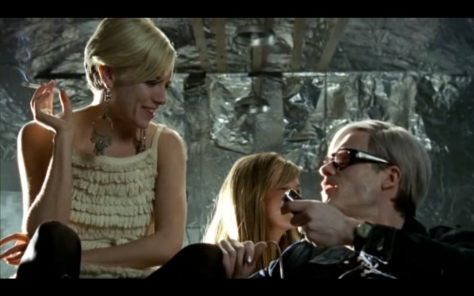By Dennis Hartley
(Originally posted on Digby’s Hullabaloo on September 12, 2009)

Radical chic(k).
The Baader-Meinhof Complex is a new German political thriller that largely eschews the thrills for the politics, with nary a sympathetic character. I feel sorry for writer-producer Bernd Eichinger and director Uli Edel. Marketing a film that dutifully recreates a 10-year reign of terror by Germany’s most notorious (and nihilistic) group of underground radicals (especially this close to another anniversary of the 9/11 attacks) has got to be a tough sell, no matter how honorable the intentions. Still, the objective viewer will find much to admire within this difficult yet rewarding 2½ hour opus.
There are three fearless and incendiary lead performances that lie at the heart of it. Martina Gedeck is a marvel as Ulrike Meinhof. Meinhof was a well-known left-wing journalist in the late 60s, when she first met radical activists Gudrun Ensslin (a super-intense Johanna Wokalek) and Andreas Baader (Mortiz Bleibtreu, who played Franka Potente’s boyfriend in Run Lola Run).
The film begins during this time period, when the couple began to make the transition from protest to action. Their firebombing of a department store (to protest the Vietnam War) made an impression on Mienhof, who was already toying with the idea of making that jump herself. Within a year of their first meeting, Meinhof was firmly in league with Baader and Ensslin, who all eventually would form the nucleus of the self-proclaimed “Red Army Faction”.
After a prison break in 1970 that freed Baader (who had earned a 3-year sentence for the department store arson) and a stint of military training in Jordan with El Fatah, the R.A.F.’s actions began to lead to an ever-increasing body count. This naturally precipitated intense pursuit by authorities, who had the three principals and most of their associates rounded up by 1972.
Although the founding members were now incarcerated for good, there would still be another five years of activities by the R.A.F. Mark II- the so-called “second generation” of the organization; this period of their history (1973-1977) accounts for the final third of the film.
It is this part of the story that I found most fascinating. It demonstrates how (although doesn’t go to any length to explore why) such radical groups inevitably self-destruct by becoming a microcosm of the very thing they were railing against in the first place; in this case, disintegrating into a sort of self-imposed fascistic state that became more and more about internal power plays and individual egos instead of focusing on their original collective idealism.
This aspect of the story strongly recalls the late German filmmaker Rainier Werner Fassbinder’s 1979 political satire, cheekily entitled The Third Generation, in which he carries the idea of an ongoing disconnect between the R.A.F.’s core ideals and what he portrays as little more than a group of increasingly clueless, bumbling middle-class dilettantes who bear scant resemblance to the original group of hardcore revolutionaries, to ridiculous extremes.
As I mentioned at the top of the review, this is not a polemic, per se. Screenwriter/producer Eichinger (who adapted from Stefan Aust’s eponymous book) has stated in an interview that the intention was neither to make “…a didactic film nor a modern morality play about German terrorism,” but rather present events as they occurred, allowing viewers to draw their own conclusion. I think they succeed in achieving this neutrality; a wise choice, as these are not the most pleasant characters to spend 2½ hours with.
This is not a film for everyone. The 150-minute running time will be daunting if you only have a passing interest in the subject matter. If you’re intrigued by the sociopolitical historical angle, and appreciate top-notch acting, you won’t be disappointed. If you go in expecting an action thriller, you may find yourself glancing at your watch.
There is a line in the film that stuck with me. It is uttered by Bruno Ganz, who plays the head of the German Federal Police Force. It’s almost a throwaway, but I think it’s significant. Unfortunately I can’t recall the exact quote, so I will paraphrase. During a strategy meeting, he says something to the effect of “In order to effectively fight terrorism, it is essential to be able to step back far enough to objectively understand the terrorist’s point of view.”
The reaction of his colleagues is very interesting; they seem aghast and quite ruffled by the fact that he would even say such a thing. It’s such a simple concept (to me, it’s a variation on the axiom, “Know thy enemy”) but so difficult for the powers-that-be to understand sometimes. It reminded me of an era not too far past (September 12, 2001-January 19, 2009 to be precise) during when such “objectivity” was interpreted by certain members of our government as “empathy” ( “unpatriotic”, “not supporting the troops”). Good times!











